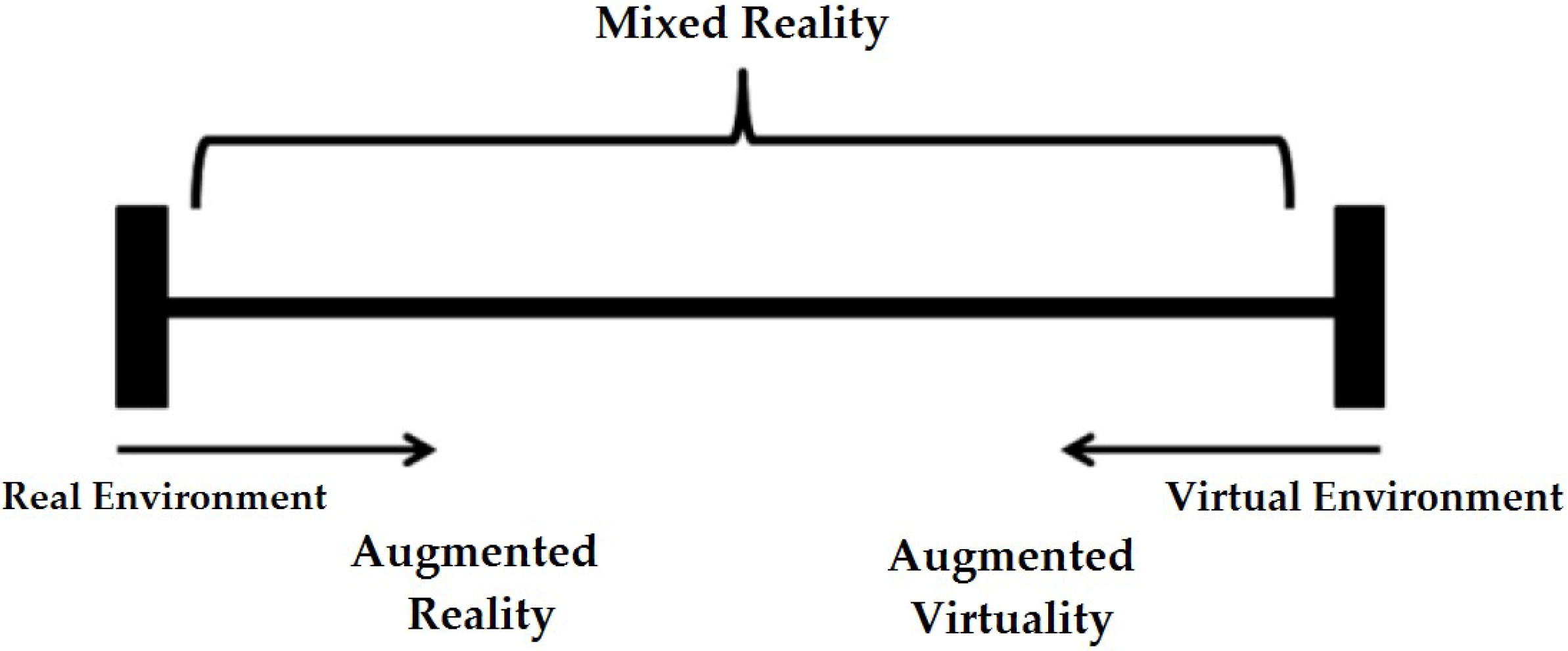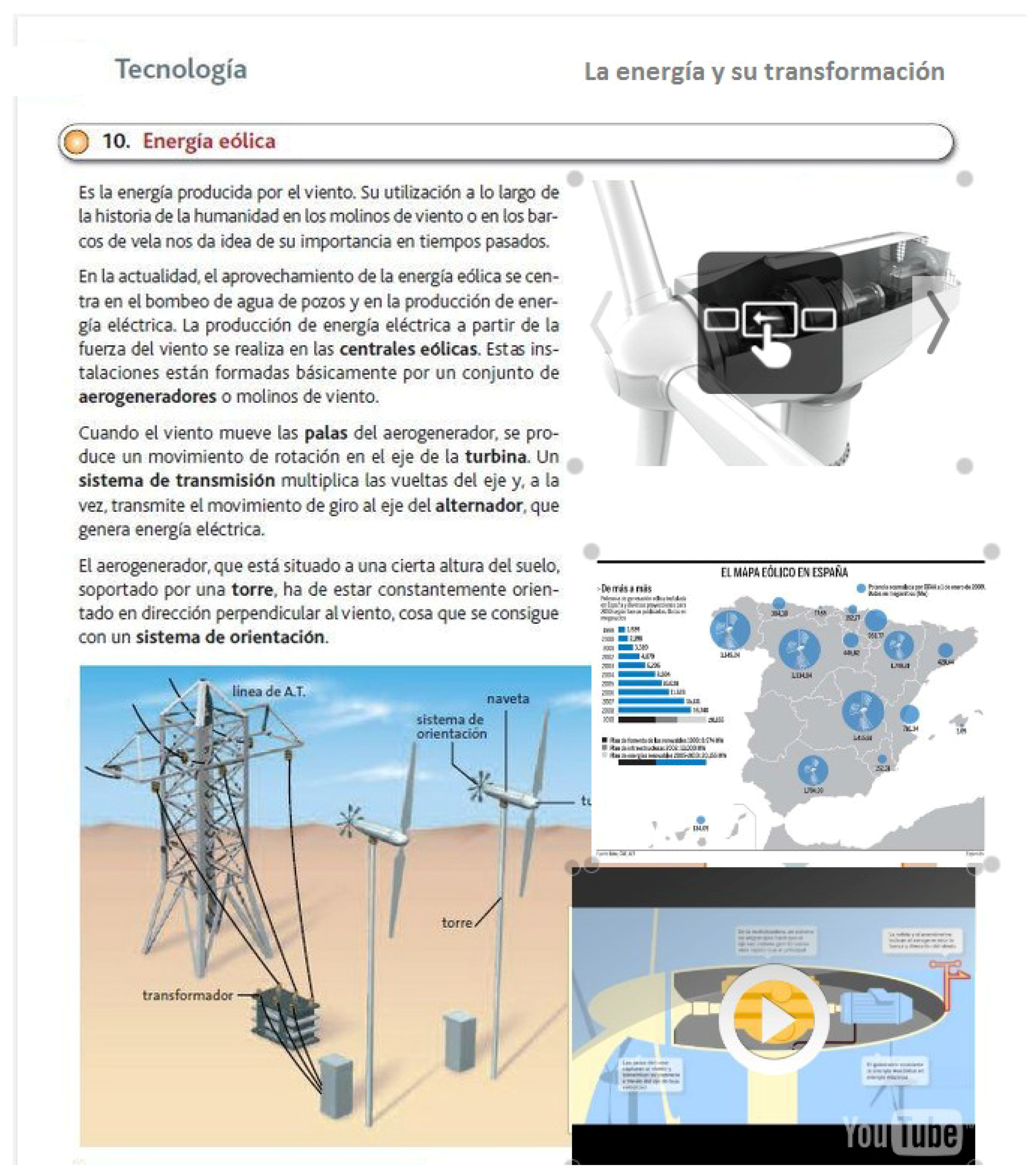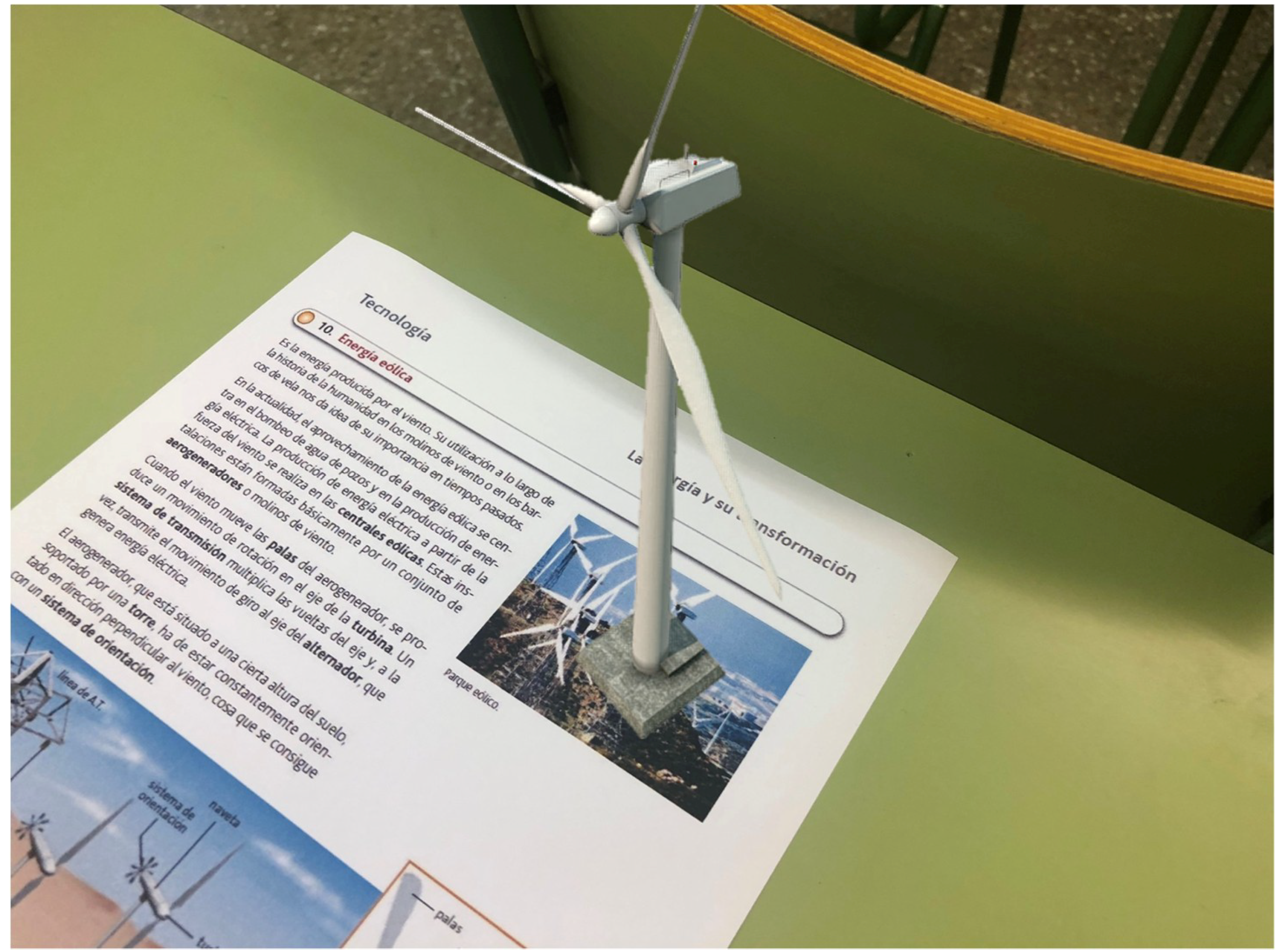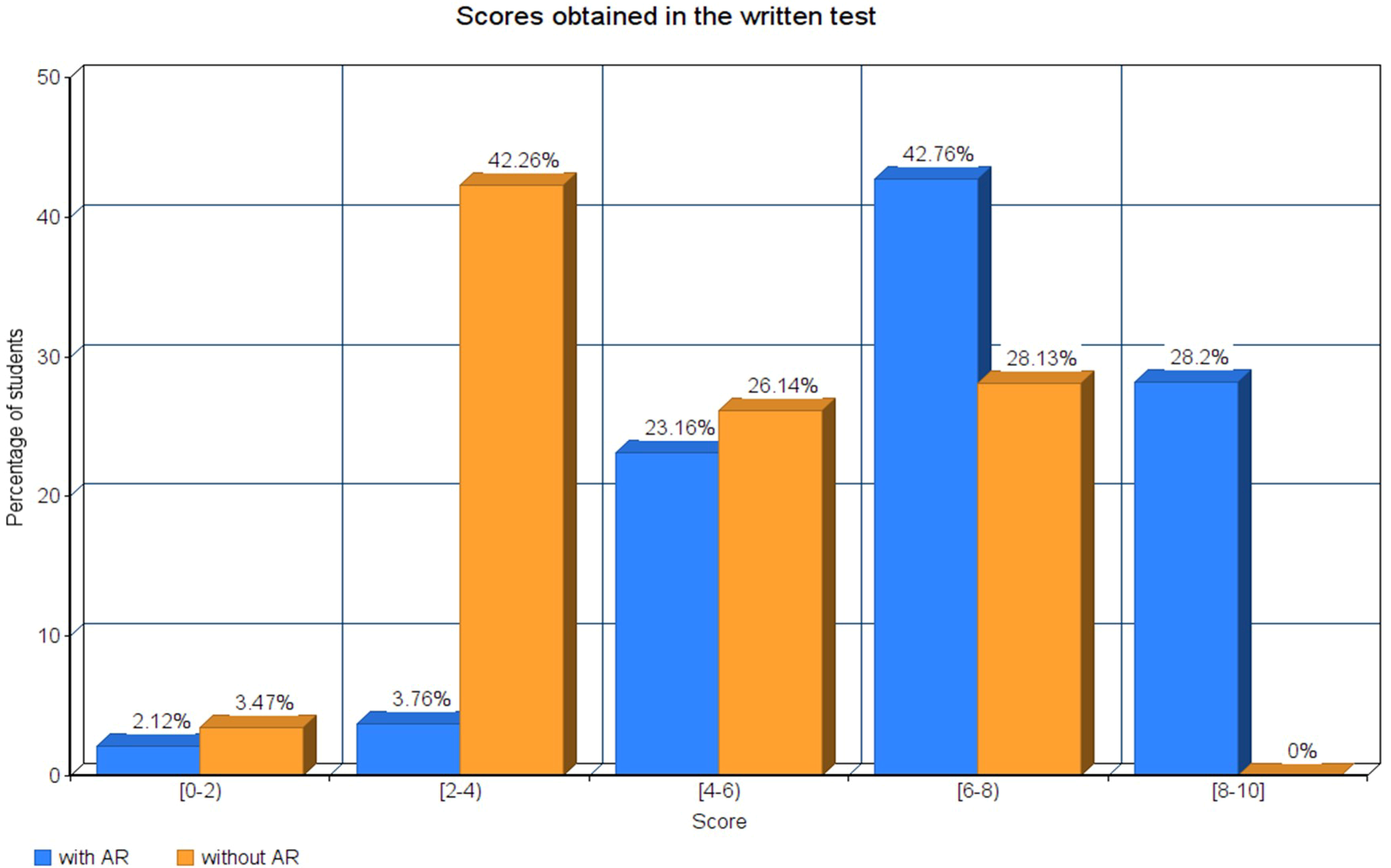Augmented Reality and Mobile Devices: A Binominal Methodological Resource for Inclusive Education (SDG 4). An Example in Secondary Education
Abstract
:1. Introduction
2. Materials and Methods
2.1. The Binomial Augmented Reality and Mobile Devices as a Methodological Resource in Inclusive Education for Sustainable Development
- (i)
- In 1994 Paul Milgram and Fumio Kishino [18] defined a continuous scale that goes from the real environment to the virtual environment, called the Reality-Virtuality Continuum. The area between the two extremes, where the “Real Environment” and the “Virtual Environment” combine, is called “Mixed Reality”, as shown in Figure 1. Within this scale, “Augmented Reality” can be distinguished as that which incorporates virtual elements in a real environment, while “Augmented Virtuality” incorporates real elements in a virtual environment.
- (ii)
- In 1997, Ronald Azuma [19] determined that an AR system has to fulfill three fundamental characteristics: that it combines real and virtual elements, that it is interactive in real time, and that it is registered in 3D.
- (i)
- Collaborative Capacity: the interaction-collaboration relationship among students is one of the primary objectives of any educational environment [34,35]. In this aspect, AR will increase the collaborative capacity of the classroom by enabling multiple users to access a shared space of virtual resources. This characteristic is especially important for any educational level, since it allows students to effectively combine numerous ICT tools through AR technology. This system of collaborative work can be further enhanced by integrating services hosting these multimedia resources in the cloud, such Google Drive, Google Classroom, Dropbox, OneDrive, etc. In this way, material is shared and made fully available for use by educators and students, without the need to pay license fees. These resources for non-commercial purposes are known as Open Educational Resources (OER).
- (ii)
- Continuous Interaction: from a traditional learning point of view, when two or more students work together in a common space, it becomes a space of communication. In this sense, by applying the appropriate technology we allow students to interact with the real world and the virtual world at the same time. During a master class, the focus is on the blackboard, digital or not; by applying AR technology attention goes beyond the collaborative work center, while the blackboard moves on to a different plane (that is not secondary) [36]. This is one of the pillars of the augmented learning environment, the union of educational technology with traditional resources such as the blackboard or textbook. In addition, by using tools such as mobile devices to carry out this type of activity within AR, students have access at all times and anywhere to these resources, which further accentuates the meaning of continuous interaction through the Mobile Learning or m-learning. The projects developed by UNESCO [37] have shown that mobile devices allow literacy, promote the motivation of students, and improve the possibilities of professional development of teachers and communication between parents and teachers.
- (iii)
- Tangibility: generally, AR allows the manipulation of an object through the use of what is known as the Tangible Interface Metaphor [38]. The teaching-learning is improved when physical objects are used, because these objects are not only a representation for students, but also encourage proactive learning through their tangibility. The use and manipulation of physical objects, as well as their semantic representations and their spatial disposition, help students towards the comprehension and learning of certain content with high visual load. AR technology allows us to recreate virtually any physical object, and, through a tangible interface, we can manipulate it to obtain information about and from it, promoting proactive learning. Therefore, AR allows physical resources to be replaced by virtual objects, which represents an educational strategy of great potential for improving the teaching-learning process in any area and for any content, where spatial intelligence is necessary, such as Science, Technology, Engineering, Art, and Mathematics (STEAM) [30].
2.2. Inclusive and Equitable Quality Education through AR and Mobile Devices
2.3. The Augmented Reality and Mobile Devices Binomial in a Technology Learning Unit
- (i)
- The use of AR technology in the teaching-learning processes.
- (ii)
- The contribution of AR tools to the better understanding of the content.
- (iii)
- The difficulty of using AR tools and applications.
- (iv)
- The memorization of content after implementing the AR techniques.
2.4. Data Analysis
3. Results
4. Discussion
5. Conclusions
Author Contributions
Funding
Acknowledgments
Conflicts of Interest
References
- Haberman, M. The pedagogy of poverty versus good teaching. Phi Delta Kappan 2010, 2, 81–87. [Google Scholar] [CrossRef]
- United Nations Educational, Scientific and Cultural Organization (UNESCO). Guidelines for Inclusion: Ensuring Access to Education for All; UNESCO Publishing: Paris, France, 2005; Available online: http://unesdoc.unesco.org/images/0026/002651/265142e.pdf (accessed on 18 June 2018).
- Leicht, A.; Heiss, J.; Byun, W.J. Issues and Trends in Education for Sustainable Development; UNESCO Publishing: Paris, France, 2018; Available online: http://unesdoc.unesco.org/images/0026/002614/261445e.pdf (accessed on 15 June 2018).
- United Nations Educational, Scientific and Cultural Organization (UNESCO). UNESCO Roadmap for Implementing the Global Action Programme on Education for Sustainable Development; UNESCO Publishing: Paris, France, 2014; Available online: http://unesdoc.unesco.org/images/0023/002305/230514e.pdf (accessed on 18 June 2018).
- United Nations Educational, Scientific and Cultural Organization (UNESCO). UNESCO Education for Sustainable Development Goals; UNESCO Publishing: Paris, France, 2017; Available online: http://unesdoc.unesco.org/images/0024/002474/247444e.pdf (accessed on 18 June 2018).
- United Nations (UN). Report of the World Commission on Environment and Development: Our Common Future; United Nations: New York, NY, USA, 1987; ISBN 9780192820808. [Google Scholar]
- United Nations Educational, Scientific and Cultural Organization (UNESCO). A Human Rights-Based Approach to Education; UNESCO Publishing: Paris, France, 2017; Available online: http://unesdoc.unesco.org/images/0015/001548/154861e.pdf (accessed on 18 June 2018).
- United Nations Educational, Scientific and Cultural Organization (UNESCO). UNESCO Education Strategy 2014–2021; UNESCO Publishing: Paris, France, 2014; Available online: http://unesdoc.unesco.org/images/0023/002312/231288e.pdf (accessed on 18 June 2018).
- Thomazet, S. From Integration to Inclusive Education: Does Changing the Terms Improve Practice? Int. J. Incl. Educ. 2009, 13, 553–563. [Google Scholar] [CrossRef]
- Escudero, J.M.; Martínez, B. Educación inclusiva y cambio escolar. Revista Iberoamericana de Educación 2011, 55, 85–105. [Google Scholar]
- Jabareen, Y. Towards a Sustainability Education Framework: Challenges, Concepts and Strategies—The Contribution from Urban Planning Perspectives. Sustainability 2012, 4, 2247–2269. [Google Scholar] [CrossRef] [Green Version]
- United Nations (UN). The Millennium Development Goals: 2015 Report; United Nations: New York, NY, USA, 2015; Available online: http://www.un.org/millenniumgoals/2015_MDG_Report/pdf/MDG%202015%20rev%20(July%201).pdf (accessed on 18 June 2018).
- United Nations Educational, Scientific and Cultural Organization (UNESCO). Education for All 2000–2015: Achievements and Challenges; UNESCO Publishing: Paris, France, 2005; Available online: http://unesdoc.unesco.org/images/0023/002322/232205e.pdf (accessed on 18 June 2018).
- United Nations Educational, Scientific and Cultural Organization (UNESCO). Education 2030: Incheon Declaration; UNESCO Publishing: Paris, France, 2015; Available online: http://unesdoc.unesco.org/images/0024/002456/245656e.pdf (accessed on 18 June 2018).
- United Nations (UN). The Sustainable Development Goals Report 2016; United Nations: New York, NY, USA, 2016; ISBN 978-992-1-101340-5. [Google Scholar]
- Crespo, B.; Míguez-Álvarez, C.; Arce, M.E.; Cuevas, M.; Míguez, J.L. The Sustainable Development Goals: An Experience on Higher Education. Sustainability 2017, 9, 1353. [Google Scholar] [CrossRef]
- Caudell, T.P.; Mizell, D.W. Augmented reality: An application of heads-up display technology to manual manufacturing processes. In Proceedings of the Twenty-Fifth Hawaii International Conference on System Sciences, Kauai, HI, USA, 7–10 January 1992; Volume 2, pp. 659–669. [Google Scholar]
- Milgram, P.; Takemura, H.; Utsumi, A.; Kishino, F. Augmented Reality: A class of displays on the reality-virtuality continuum. Telemanipulator Telepresence Technol. 1995, 2351, 282–292. [Google Scholar]
- Azuma, R. A Survey of Augmented Reality. Presence Teleoper. Virtual Environ. 1997, 6, 335–385. [Google Scholar] [CrossRef]
- Zhou, F.; Duh, H.; Billinghurst, M. Trends in augmented reality tracking, interaction and display: A review of ten years of ISMAR. In Proceedings of the 7th IEEE/ACM International Symposium on Mixed and Augmented Reality, Cambridge, MA, USA, 15–18 September 2008; pp. 193–202. [Google Scholar]
- Lee, K. Augmented Reality in Education and Training. TechTrends 2012, 56, 13–21. [Google Scholar] [CrossRef]
- Prendes, C. Realidad aumentada y educación: Análisis de experiencias prácticas. Pixel-Bit. Revista de Medios y Educación 2015, 46, 187–203. [Google Scholar]
- Schmalstieg, D.; Höllerer, T. Augmented Reality: Principles and Practice; Addison-Wesley: Boston, MA, USA, 2016; ISBN 978-0321883575. [Google Scholar]
- Chang, G.; Morreale, P.; Medicherla, P. Applications of augmented reality systems in education. In Proceedings of the Society for Information Technology & Teacher Education International Conference, San Diego, CA, USA, 29 March 2010; Gibson, D., Dodge, B., Eds.; AACE: Chesapeake, VA, USA, 2010; pp. 1380–1385. [Google Scholar]
- Baldiris, S.; Duque, N.; Salas, D.; Bernal, J.; Fabregat, R.; Mendoza, R.; Puerta, Y.; Puello, J.; Solano, I.; Martínez, L. Recursos Educativos Aumentados. Una Oportunidad para la Inclusión; Sello Editorial Tecnológico Comfenalco: Cartagena de las Indias, Colombia, 2016; ISBN 978-958-59656-0-7. [Google Scholar]
- Olesky, T.; Wnuk, A. Augmented places: An impact of embodied historical experience on attitudes towards places. Comput. Hum. Behav. 2016, 57, 11–16. [Google Scholar]
- Jeong, B.; Yoon, J. Competitive Intelligence Analysis of Augmented Reality Technology Using Patent Information. Sustainability 2017, 9, 497. [Google Scholar] [CrossRef]
- Dunleavy, M.; Dede, C.; Mitchell, R. Affordances and Limitations of Immersive Participatory Augmented Reality Simulations for Teaching and Learning. J. Sci. Educ. Technol. 2008, 18, 7–22. [Google Scholar] [CrossRef]
- Martínez-Graña, A.M.; González-Delgado, J.; Pallarés, S.; Goy, J.L.; Llovera, J.C. 3D Virtual Itinerary for Education Using Google Earth as a Tool for the Recovery of the Geological Heritage of Natural Areas: Application in the “Las Batuecas Valley” Nature Park (Salamanca, Spain). Sustainability 2014, 6, 8567–8591. [Google Scholar] [CrossRef] [Green Version]
- Del Cerro, F.; Morales, G. Augmented Reality as a tool for improving spatial intelligence in secondary education students. Revista de Educación a Distancia 2017, 54, 5. [Google Scholar]
- Marshall, C. Reading and interactivity in the digital library: Creating an experience that transcends paper. In Proceedings of the CLIR/Kanazawa Institute of Technology Roundtable, Kanazawa, Japan, 28 October 2005; Volume 5, pp. 1–20. [Google Scholar]
- Billinghurst, M.; Kato, H.; Poupyrey, I. The magicbook-moving seamlessly between reality and virtuality. IEEE Comput. Graph. Appl. 2001, 21, 6–8. [Google Scholar]
- Jonhson, L.; Levine, A.; Smith, R.; Stone, S. The 2010 Horizon Report; New Media Consortium: Austin, TX, USA, 2010; ISBN 978-0-9825-3343-7. [Google Scholar]
- Roussos, M.; Jhonson, A.; Moher, T.; Leigh, J.; Vasilakis, C.; Barnes, C. Learning and Building Together in an Immersive Virtual World. Presence Teleoper. Virtual Environ. 1999, 8, 247–263. [Google Scholar] [CrossRef] [Green Version]
- Ballew, M.T.; Omoto, A.M.; Winter, P.L. Using Web 2.0 and Social Media Technologies to Foster Proenvironmental Action. Sustainability 2015, 7, 10620–10648. [Google Scholar] [CrossRef] [Green Version]
- Kiyokawa, K.; Billinghurst, M.; Hayes, S.; Gupta, A.; Sannohe, Y.; Kato, H. Communication Behaviors of Co-Located Users in Collaborative AR Interfaces. In IEEE and ACM International Symposium on Mixed and Augmented Reality; IEEE Computer Society Press: Darmstadt, Germany, 2002; pp. 139–148. [Google Scholar]
- United Nations Educational, Scientific and Cultural Organization (UNESCO). Policy Guidelines for Mobile Learning; UNESCO Publishing: Paris, France, 2013; Available online: http://unesdoc.unesco.org/images/0021/002196/219641E.pdf (accessed on 18 June 2018).
- Billinghurst, M. Augmented reality in education. New Horiz. Learn. 2002, 12, 5. [Google Scholar]
- ICT in Education Prize. Available online: https://en.unesco.org/themes/ict-education/ict-education-prize (accessed on 18 June 2018).
- Fambona, J.; Pascual, M.Á.; Madeira, M.F. Realidad aumentada una evolución de las aplicaciones de los dispositivos móviles. Pixel-Bit. Revista de Medios y Educación 2012, 41, 197–210. [Google Scholar]
- Valero, M. Tecnologías para la Educación Inclusiva: De la integración a la interacción. In 25 Años de Integración Escolar en España: Tecnología e Inclusión en el Ámbito Educativo, Laboral y Comunitario; Arnaiz, P., Hurtado, M.D., Soto, F.J., Eds.; Consejería de Educación, Formación y Empleo: Murcia, Spain, 2010; pp. 1–5. ISBN 978-984-693-1781-5. [Google Scholar]
- StatCounter GlobalStats. Mobile and Tablet Internet Usage Excedes Desktop for First Time Worldwide. Available online: http://gs.statcounter.com/press/mobile-and-tablet-internet-usage-exceeds-desktop-for-first-time-worldwide (accessed on 18 June 2018).
- Adams Becker, S.; Cummins, M.; Davis, A.; Freeman, A.; Hall Giesinger, C.; Ananthanarayanan, V. The NMC Horizon Report: 2017 Higher Education Edition; New Media Consortium: Austin, TX, USA, 2017; ISBN 978-0-9977215-7-7. [Google Scholar]
- Campillo, E.; Ricarte, J.J.; Ros, L.; Nieto, M.; Latorre, J.M. Effects of the Visual and Auditory Components of a Brief Mindfulness Intervention on Mood State and on Visual and Auditory Attention and Memory Task Performance. Curr. Psychol. 2018, 37, 357–365. [Google Scholar] [CrossRef]
- Steding, J.; Holthoff-Detto, V. Kognitive Reserve und Potenzial im Alter. DNP Der Neurologe und Psychiater 2016, 17, 50–58. [Google Scholar] [CrossRef]
- Rönnlund, M.; Sundström, A.; Pudas, S. Midlife level and 15-year changes in general cognitive ability in a sample of men: The role of education, early adult ability, BMI, and pulse pressure. Inelligence 2017, 61, 78–84. [Google Scholar] [CrossRef]
- Lenehan, M.E.; Summers, M.J.; Saunders, N.L.; Summers, J.J.; Vickers, J.C. Relationship between education and age-related cognitive decline: A review of recent research. Psychogeriatrics 2015, 15, 154–162. [Google Scholar] [CrossRef] [PubMed]
- Kaufmann, H.; Schmalsteig, D. Mathematics and geometry education with collaborative augmented reality. In Proceedings of the ACM SIGGRAH 2002 Conference Abstract and Applications, San Antonio, TX, USA, 21–26 July 2002; pp. 37–41. [Google Scholar]
- Layar. Available online: http://www.layar.com (accessed on 18 June 2018).
- Tilbury, D.; Janousek, S.; Elias, D.; Bacha, J. Asia-Pacific Guidelines for the Development of National ESD Indicators; UNESCO: Bangkok, Thailand, 2017; Available online: http://unesdoc.unesco.org/images/0015/001552/155283e.pdf (accessed on 18 June 2018).
- Zou, Y.; Zhao, W.; Mason, R.; Li, M. Comparing Sustainable Universities between the United States and China: Cases of Indiana University and Tsinghua University. Sustainability 2015, 7, 11799–11817. [Google Scholar] [CrossRef] [Green Version]
- Waltner, E.-M.; Rieß, W.; Brock, A. Development of an ESD Indicator for Teacher Training and the National Monitoring for ESD Implementation in Germany. Sustainability 2018, 10, 2508. [Google Scholar] [CrossRef]
- Ketschau, T.J. A Conceptual Framework for the Integration of Corporate Social Responsibility and Human Resource Development Based on Lifelong Learning. Sustainability 2017, 9, 1545. [Google Scholar] [CrossRef]
- Radomska, J. The Concept of Sustainable Strategy Implementation. Sustainability 2015, 7, 15847–15856. [Google Scholar] [CrossRef]
- Fleacă, E.; Fleacă, B.; Maiduc, S. Aligning Strategy with Sustainable Development Goals (SDGs): Process Scoping Diagram for Entrepreneurial Higher Education Institutions (HEIs). Sustainability 2018, 10, 1032. [Google Scholar] [CrossRef]
- Bertschy, F.; Künzli, C.; Lehmann, M. Teachers’ Competencies for the Implementation of Educational Offers in the Field of Education for Sustainable Development. Sustainability 2013, 5, 5067–5080. [Google Scholar] [CrossRef] [Green Version]
- United Nations Educational, Scientific and Cultural Organization (UNESCO). UNESCO International Forum on ICT and Education 2030, 2017 Quingdao Statement: Strategies for Leveraging ICT to Achieve Education 2030; UNESCO Publishing: Paris, France, 2017; Available online: http://unesdoc.unesco.org/images/0025/002530/253061m.pdf (accessed on 18 June 2018).






| Tool | Method |
|---|---|
| Written Test Group 1 (with AR) | Each student is required to complete a written test independently |
| Written Test Group 2 (without AR) | Each student is required to complete a written test independently |
| Questionnaire Group 1 (with AR) | Each student completes a personal questionnaire |
| N | Maximum | Minimum | Median | Media | Std. Deviation | Std. Error Mean | |
|---|---|---|---|---|---|---|---|
| Group 1 | 29 | 9.6 | 2.1 | 7.6 | 7.51 | 17.75842 | 3.723 |
| Group 2 | 27 | 7.2 | 1.8 | 4.1 | 4.48 | 15.69714 | 3.248 |
| Levene’s Test for Quality of Variance | t-Test for Equality of Means | |||||||||
|---|---|---|---|---|---|---|---|---|---|---|
| F | Sig. | t | df | Sig. (2-Tailed) | Mean Difference | Std. Error Difference | 95% Confidence Interval of the Difference | |||
| Lower | Upper | |||||||||
| Marks | Equal variances assumed | 0.058 | 0.842 | 4.392 | 52.014 | 0.000 | 3.03 | 4.697 | 1.152 | 3.084 |
| Equal variances not assumed | 4.431 | 51.976 | 0.000 | 3.03 | 4.651 | 1.147 | 3.075 | |||
© 2018 by the authors. Licensee MDPI, Basel, Switzerland. This article is an open access article distributed under the terms and conditions of the Creative Commons Attribution (CC BY) license (http://creativecommons.org/licenses/by/4.0/).
Share and Cite
Del Cerro Velázquez, F.; Morales Méndez, G. Augmented Reality and Mobile Devices: A Binominal Methodological Resource for Inclusive Education (SDG 4). An Example in Secondary Education. Sustainability 2018, 10, 3446. https://doi.org/10.3390/su10103446
Del Cerro Velázquez F, Morales Méndez G. Augmented Reality and Mobile Devices: A Binominal Methodological Resource for Inclusive Education (SDG 4). An Example in Secondary Education. Sustainability. 2018; 10(10):3446. https://doi.org/10.3390/su10103446
Chicago/Turabian StyleDel Cerro Velázquez, Francisco, and Ginés Morales Méndez. 2018. "Augmented Reality and Mobile Devices: A Binominal Methodological Resource for Inclusive Education (SDG 4). An Example in Secondary Education" Sustainability 10, no. 10: 3446. https://doi.org/10.3390/su10103446
APA StyleDel Cerro Velázquez, F., & Morales Méndez, G. (2018). Augmented Reality and Mobile Devices: A Binominal Methodological Resource for Inclusive Education (SDG 4). An Example in Secondary Education. Sustainability, 10(10), 3446. https://doi.org/10.3390/su10103446






